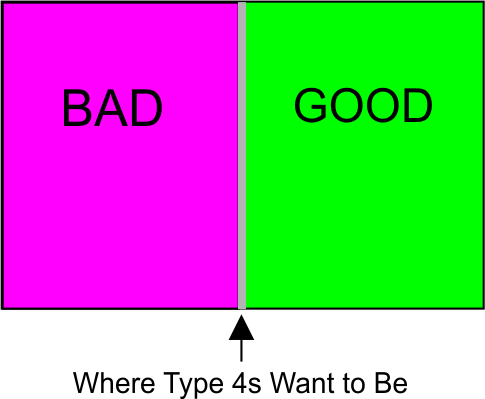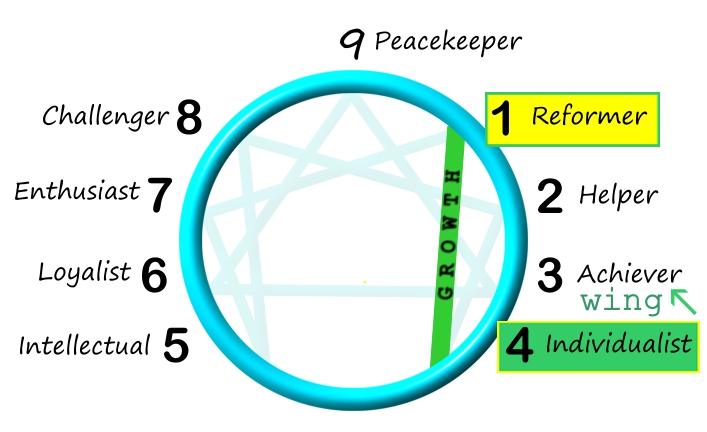
WHAT’S UNDER THE HOOD
Peek under the hood of
If the engine doesn’t impress you, the paint job should, because it’s an incredible work of art. If you asked the Type Four how they came up with the design, they would tell you it represents their struggle, their personal journey. That’s after they told you, “This design was much better, than last months, but maybe not better than last years.”
Does this car go fast? Does it even go at all? You’re not sure, but you are confident that it belongs in an art gallery. That is, if you can find the owner. They were just here a minute ago, and they’re gone.
“To be, or not to be, that is the question
– William Shakespeare.. .”
KEY INGREDIENTS OF A TYPE FOUR “INDIVIDUALIST”
- They love talking about their problems and their personal journey.
- Their favorite subject is themself.
- Expressive and very emotional
- Artistic and creative
- speak and live through their art.
- their art, whatever it may be, is an expression of their soul
- View the world through a metaphoric lens
- meaning their truth, can vary greatly from reality
- Highly introverted. Feels cast out by a society that doesn’t understand them.
- Can get offended very easily, easily slighted, playing the victim often.
- On a never-ending journey to find themselves.
- Can easily overcomplicate the simplest of tasks.
- Like a type three, they can be very much image-oriented. But unlike a type three, whose image usually is associated with success, a four’s image takes a back hand, or even a middle finger to the norms of society.
WHAT’S THEIR AGENDA?
To find their purpose in life, their meaning, the reason why they exist.
THEIR IMMEDIATE DEFENSE TO CONFLICT
When a Type Four is triggered, they will immediately lose confidence in who they are, their purpose in the world – their identity. The Fours immediate reactions can be hysterical, combative, very emotional. In extreme cases, self-harm can often occur.
WHAT IS THEIR GREATEST FEAR?
Fours are lost within themselves and can struggle to assimilate with society. Unlike other personalities, they have many fears (way too many to count) and often complicate their feelings.
For example:
- They fear being misunderstood, but they never want anyone to really know them.
- They have a fear of having no place in society, yet they feel society is boring.
- They fear never being content in life, but their struggle defines them.
- They don’t want to be a victim, but they wear victimhood as a badge of honor.
- They fear not being authentic, but their identity tends to always be a mirage.
WHO ARE THE TYPE FOURS IN THE REAL WORLD?
More than 95% of the artists in the world are more than likely, Type Four Personalities. That includes authors, painters, hairstylists, musicians, directors, photographers, dancers, and almost every celebrity who works in entertainment. Type Fours are the creative ones!
Prince wore his creativity.
Prince is probably your prime example of a typical Type Four Individualist. Who they truly are, we don’t know. The image they choose to portray to the public is usually drastically different from those in private. His wardrobe is an extension of his personality, not just an outfit. And when it comes to his music, his lyrics always tend to have a double meaning. To this day, we still don’t know exactly what they mean.
At one time, Prince abandoned his name and identified as a symbol which was some weird version of the male-female insignia. I believe he did this for a few years until switching back. He was a recluse, and interviews with him were very hard to come by. Many journalists who did interview him, just wasn’t sure which Prince would show up, the nice one or the mean one. Again, that is a Typical Type Four.
Pierre XO is a perfect example of a healthy Type Four personality. He is someone who has created an identity that flies in the face of normalcy. But never judge a book by its cover. Pierre is very confident in his own skin, and can now look outwards, rather than compulsively inwards. Healthy Type Fours can often sound as critical as a Type One Reformer, pointing out every single flaw in society, and others around them. The difference between a Type One and Type Four’s criticism? Well, a Type Four, when healthy (that’s key), is often the master of the metaphor, and can come off a little softer than a Type One. Now, if they are not healthy, they can be very much, histrionic.
Caitlyn Jenner created an image and is confident of her choice, with no regrets.
Caitlyn Jenner is more than likely, a Type Four Personality, and possibly even a Healthy one. She has found her identity, her place in the world, and a purpose. She is still oversensitive, but she assimilates with society well.
Not all transgenders are Type Fours, but I would gamble and say the vast majority of them are. Identities is an accessory Type Fours love to try on, like hats. And lately, gender transitioning has become very fashionable. Unfortunately, these accessories are viewed as solutions to deeper problems, and gender transitioning has not solved the underlying issues of that individual. Affirming psychologists (which is an oxymoron) are using gender-transitioning as a solution for a Type Four who is struggling to find their purpose in life.
Many Transgenders can be Type Fours, but that doesn’t mean all of them are!
Feminine gay men, also tend to be of this personality type. If you notice, many gays excel in the arts and are naturally creative, which is a Type Four trait.
WHAT IS THEIR SPIRIT ANIMAL?
Nothing represents Type Fours better than a peacock. These animals are naturally introverted, yet at the same time, crowd-stopping. Blending in with their environment is the last thing on their mind when they reappear. They want to make an entrance.
FICTIONAL EXAMPLES
In a fictional setting, the real question should be, “What character IS NOT a Type Four?” Most screenwriters and directors are Type Fours, and many have unknowingly self-projected themselves into
Almost every character in Star Wars was a Type Four
In the movie The Last Jedi, every significant character is a Type Four. Rey is on a mission to find herself. Kylo Ren is not sure where he belongs. Princess Leia is lost without Luke. Luke doesn’t want to play the hero anymore, and Fin doesn’t want to be part of the Rebels.
FORMULAIC FOURS IN MOVIES
The typical protagonist in a modern movie is usually a version of
Then eventually, something happens to our heroes. They get a superpower, find a purpose, and start a journey towards their new identity. Once the heroes find their identity, then and only then can they save the damsel, save the town, and then the world.
This formula is repeated over and over again.
There’s nothing wrong with using Type Fours as the foundation for heroes. But can we maybe try a different personality type?
Comic writers, unlike movie writers, created heroes with different personalities: Deadpool and Wolverine were Type Eights. Iron Man was a Type Three. Superman a Type Two, Batman an Unhealthy One, Spider-Man a type Nine, and Dr. Strange a type Five.
Why do screenwriters use the same personality type over and over again? It’s very simple. They self-project themselves onto characters they create, unknowingly – and then self-project their personal agendas to the forefront, purposely. The result is “a lot of blah”

~ THE JOURNEY OF DISCOVERY ~
Type Fours are on an endless treasure expedition, but it’s not gold they’re hunting. They’re in pursuit of two riches that they consider unattainable, an identity and a purpose.
A type four will try on many identities (images) throughout their life as though they were an accessory. For example, that identity could sometimes be as simple as a photographer. The Type Four would buy all the photo equipment, learn the skill, learn the lingo, so they could be identified in society as a photographer. But ironically, he or she would never actually become a great photographer or a professional one, despite playing the part. Within a year or two, the Type Four would have given up the image of being a
The Type Four’s relationship with their identity directly affects every aspect of their life.
Fours often create an identity to rebel against society
A Harijaku Girl is an example of a Type Four’s image. It’s part of who they are. It’s not just clothes, a wig, or colorful attire to them. It’s who they are. They are more comfortable in the image they created than what they were naturally born into.
Healthy Fours are very secure in their identity. They are not easily offended and tend to live with a purpose greater than themselves. I want to point out here that just because their identity may be considered strange, abnormal, or even crazy, it doesn’t mean that they are Unhealthy. A
Average Fours have settled on an identity and a purpose in life, even if they aren’t comfortable. They can live with an identity that they are not comfortable with. Average Fours may try on a new identity one day if it makes sense – keyword being “makes sense.” They can be withdrawn, but overall, they tend to get out and assimilate with the public.
An Unhealthy Four is insecure in the authenticity of their identity, and this tends to make them over-sensitive, withdrawn, and easily offended. Their sole purpose in life also tends to be about them, rather than others.
THEIR FUNCTION IN LIFE
Without Fours in this world, it would be a very boring place to live in. Fours truly make everything more enjoyable, more inspirational, and a lot more creative. Fours create most of the art that we love to watch and listen to. They create the songs couples dance to, the breakup songs we cry to. Could you imagine living on a planet with no great novels to read, or movies to watch? How about no music to listen to? I would not want to live in a world without fours.
AVERAGE CHARACTERISTICS OF A TYPE FOUR
Besides searching for an identity and finding a purpose, most Type Fours tend to view the world as though it is a living metaphor. Nothing is absolute, and almost everything is subjective. Fours can be open to every idea. They challenge the status quo, sometimes in thought, most often with art, and sometimes with their identity.
If there were such thing as a personality that thinks 100% with their heart, the Four would fit the bill. They are all about feelings and emotions. Art moves them, and nature makes them cry. The right poem can strike a chord. They actually have more of a problem with people than animals, but who doesn’t?
And then, there’s there’s the flip side.
They also tend to have a magnetic attraction to the dark world. I’m not trying to throw an insult here because Fours are not seeking evil, injustice, or danger. They are just fascinated with; the supernatural, the grotesque, or the abnormal – even death.

If you were to take a life and divide it halfway between the bad and good, the little thin purgatory line separating the two, is where the Four loves to be. Not exactly bad, not exactly good. Not exactly rejected by society, but still part of it. Not ordinary, not strange, but accepted. Not rich, not middle-class, but knowing enough about the struggle to relate to the unfortunate, and not poor enough to starve.
Average Fours tend to be natural introverts. They are not anti-social. They need time away from people to recharge. Socializing can be a draining effort for them.
Fours are masters of the metaphor. For example, they can make sad love stories ironically very attractive and enjoyable to listen to.
Now when it comes to art, this is where things get really interesting. Because the typical Type Four does not think in context, they often see the light where there is dark – and then dark where there is light. For example, do you notice that most love songs are actually about the hardships of relationships? The struggle, the heartaches, the breakups. Fours see the beauty in that conflict. Even Shakespeare wrote about tragic comedies – yeah, those are two words that shouldn’t really go together. Take a look at the movies artists produce, especially those that are not commercial and are very popular in the art scene. They can get pretty dark and twisted. It’s almost a habit for artists to try to pass off their infatuation with the grotesque as an artistic expression. Their attraction to “the dark” is undeniable.
And that brings us to the next subject – context.
Viewing the world out of context is one of the greatest strengths and weaknesses.
- STRENGTH – As I mentioned, they can see the light where many don’t. When the odds are stacked against success, they can always stay blindly hopeful. This is why there are so many struggling artists out there in the world, hoping for the big break in their 40s.
- WEAKNESS – They often misinterpret the truth. A simple statement such as “You look great today” can be interpreted as “So, you’re telling me I don’t look great on the other days.” Thinking out of context often makes Fours rather gullible. They don’t need proof to validate any prejudice. All they need is to feel moved, and that’s enough proof for them – yes, that is a weakness.
THERE IS AN “I” IN TYPE FOUR
Fours are
It’s a “me first world” to the Type Four. Everyone else is second, thus the title of the personality “The Individualist.” And while this may sound like a negative, it’s honestly not. Fours feel that they have to improve upon themselves before helping others. And that’s actually a good thing – if you really think about it. We can only truly help from a place of strength, not weakness.

TRIGGERS OF THE TYPE FOUR
The trigger line of the Four goes directly to
Fours are all about “being authentic.” In fact, it’s one of their “sayings.” I mean, they do say it a lot. They are all about things being authentic. That’s why they want: their cows grass-fed, their
Ironically, when they are triggered or unhealthy, they become what they fear – like all personalities. They can become fake, lost in a world of imaginary anger, and unrealistic goals.
THE UNHEALTHY TYPE FOUR
At this point, the Unhealthy Four has most likely gone through a handful of failed identities and is cloaked in a cloud of despair, and desperation. Their identities have not only failed, but they realize their identities are not real. And their greatest fear of not being authentic has come true.
The easy solution to their problems is accepting the ugly truths and hardships of the real world and moving forward. Stop obsessing about “finding themself” and “be” themself. But that’s easier said than done for the Type Four. Finding an identity is everything to them.
A Type Four’s insecurity levels are tied directly to the state of their identity. When their identity is secure, they are confident in who they are, no matter what people may think. When their identity is recognized as a farce by others, and especially by themselves (even though they deny it) – their insecurity levels take a plunge and they become offended very easily. Drug and alcohol abused are common at this level. Self-harm could be an option too.
At this point, Unhealthy Type Fours are angry, depressed, and can take offense to even the most non-offensive comments.
Type Four’s hate to have their identities questioned.
Ever use the wrong pronoun around an Unhealthy Type Four who just happens to be a transsexual? It’s not pretty. No pun intended.
Jussie Smollet played a fictional victim in real life to garner attention.
These women pretended to be rape victims to be part of a movement.
The Native American that pretended to be a victim of white racism.
VICTIMHOOD AS AN IDENTITY
In the early
Now, “victimhood” has become an identity. I don’t know the reason why it’s happening – but it is.
Fours are identifying themselves as victims when there is no crime. They are going so far as to create fake stories, to label themselves as victims in the media. Unhealthy Fours claim to be a victim of constant racism, sexism, wealth discrimination, and so on (the list is too long). They are not chasing money or fame. It is their way of championing a cause they believe to be real, so they must play the victim – to be authentic – even though, they are not a victim. (Does that sound confusing?)
Transgenderism could be a temporary identity
GENDER IDENTITY CRISIS – THE ULTIMATE UNHEALTHY TYPE FOUR?
Not all transgenders are searching for an identity. They could be extremely confident in who they are, such as Bruce Jenner, but many are not.
There is a large portion of those are questioning their gender, who are definitely Unhealthy in their search to find themself. And they are using their gender to express an identity, instead of their clothes, hair color, tattoos, or artistic creations.

GROWTH FOR A TYPE FOUR
The growth line rockets straight up to the Type One Reformer. This means in order for a Type Four to grow, they must inherit the healthy characteristics of
Thinking WITHOUT feelings, is a very difficult step for the Type Four. For a Type Four, it’s almost as hard as putting a man on the moon. This personality will struggle to separate objectivity from subjectivity, but it must be done for this personality to grow. They must make decisions that are properly right, rather than one that feels and looks right, or a choice they feel their newly minted identity would think is right.
A healthy Type Four can separate fiction from reality. In many cases, this means separating their fictional created identity with reality. At times, this could be close to impossible for a Type Four, because their identity, which they settled on, is tied to their persona.
For growth, it also helps that the Type Four embraces their Three Wing. Fours are natural introverts and can spend too much time contemplating, and stuck in deep thoughts. Threes get things done. Could you imagine, a creative personality who gets things done, and thinks objectively? They’d become a very successful artist. By the way, most celebrities are Type Fours who have embraced their Three Wing.
THE HEALTHY TYPE FOUR
“NEVER JUDGE A BOOK BY ITS COVER” When it comes to a Healthy Type Four, that’s really a good rule of thumb to follow. The image they have created, may tempt you to jump to stereotypes, but don’t do it.
Caitlyn Jenner’s choice to identify as a woman may lead you to believe that she has a mental disorder and is a hardcore liberal. But she clearly is comfortable in her decision, is conservative in her politics, and an avid supporter of
Healthy Type Fours have found their identity and are very secure in who they are. Their identity usually still does not conform to cultural norms. If they are an artist, they can still be flamboyant, expressive, and very histrionic.
Healthy Type Fours can look like a Type One
But, the Healthy Four will not be easily offended. They will not misinterpret innocent actions as a slight. They still will view the world slightly out of context, but be much more positive than negative.
Their purpose is no longer about finding an identity as they have larger platforms to concern themselves with.
THE STRENGTH OF THE METAPHOR
Type Fours habitually, think out of context. For this personality, the truth is never a straightforward answer; it’s always complicated. And it’s always mixed with feelings, and lost in a maze of questions.
While metaphoric thinking may sound strange to the rest of us, where would we be without it? Sometimes, criticism is best made through the metaphor, rather than directly, so feelings don’t get hurt. Music is never an exact interpretation of reality. Art wouldn’t be as enjoyable if it were contextual. As you can see, the metaphor has its positives.
MISCHARACTERIZATIONS
When you think of Fours, think Emo, think Goth. Think of the flamboyant wardrobe decisions of Elton John, Prince, or Michael Jackson. Most artists are Type Fours, and are easy to spot. The Fours that are more difficult to pick out, are the ones who don’t wear their creativity on their sleeves.
Sometimes, Type Threes may be mistaken for Type Fours because threes care as much about their image as Type Fours. But there’s a big difference. A Type Three’s image is used to impress and parade their achievements. A Type Four’s image is an extension of their soul.
Healthy Type Fours will sound very much like Healthy Type Ones. They will have a cause that’s greater than their own. The main difference is that a Four’s cause will have to do somewhat with their identity. For example, Caitlyn Jenner lobbies for LGBTQ.
The greatest mischaracterization of a Type Four would be the depressed
WORKING WITH A TYPE FOUR
Type Fours can be both a blessing and a headache to work with. They are blessings because many of them can be extraordinarily creative, artistic, and innovative.
The downside?
They can be challenging to work with. Type Fours can have a “my way or the highway” mentality regarding their creations. You’ve heard about the egos of celebrities, most of who are Fours. It can be that difficult, even when a Four is not famous.
There’s no compromise in a Four’s creative process unless that Four is healthy. Sometimes, for a Type Four to work efficiently, they may require a particular work environment that allows them to feel the answer. Have you ever heard someone say, “I’m just NOT feeling it” at work? That’s most likely a Type Four.
The moral of the story is to make sure your Four that you’re collaborating with, is healthy. If not – be ready to accommodate their demands because there will be no middle ground.
Okay, the Type Four is done! Onto the Type Five!



